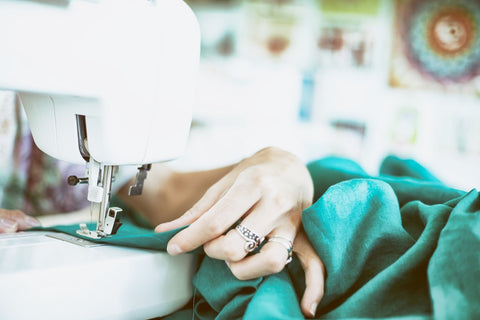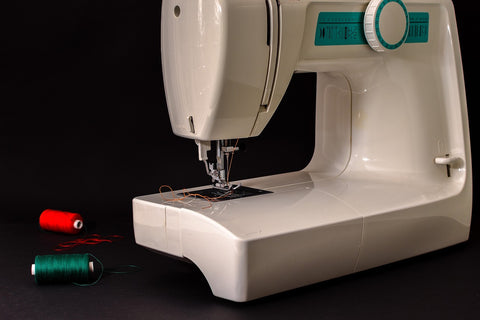Choosing Your First Sewing Machine – What Questions You Need to Ask Yourself by Helen Spencer of Hello Sewing
Posted by Bianca Howell on

Choosing the right sewing machine for yourself can be quite tricky. There are so many different types out there and so many manufacturers on the market.
It gets even more difficult when it's your first time. You don't know what to search in a sewing machine, where to look for it, and how much you should pay for it. You also don't want to make the wrong choice and buy a bad model. The room is starting to spin and now you're in a real pinch.
Worry not, this article should help you make the right choice and buy the best possible machine, appropriate for your needs.
What kind of sewing work you will focus on?
Some sewing machines are better at completing certain tasks than others. That's why you must first decide what kind of sewing projects you'll be working on. Only after you've done that, you can go ahead and search an appropriate model to buy. Let's see which features and capabilities are necessary for different sewing tasks.
Repairs and alterations
If you plan on primarily doing mending work with your sewing machine, here's what you'll need. A free arm that will make hemming much easier. It will hold a sleeve or a pant leg in position while you work on it. Your machine should also have a blind hem presser foot and a blind hemming stitch option. With these, you will be able to hem almost anything with ease, from dresses to pants and skirts.
Keep in mind that sewing thick and strong fabrics like denim requires a powerful, heavy duty machine. Likewise, working with thin and delicate fabrics require a machine of higher quality, cheap ones will end up tearing the material.
Home decor
You can use your sewing machine to make new pillows, bedsheets, or curtains and customize your living space whenever you want. For this kind of projects, your machine should have an automatic option that will give your home decor a professional look.
Curtains are usually very thick, so if you plan on making or altering them, search for a machine that can feed many layers of thick fabric.
Garments
You don't need a lot of stitches to create garments. You only need a few most important ones. Straight, stretch and zig zag stitch, along with an automatic buttonholer and the option to change the needle position so that you can sew zippers. With only these five features, you will be able to create practically any kind of garment. Backstitch option is also welcomed because it strengthens your stitch and prevents it from falling apart.
What is your budget?
The budget you're working with is obviously the main factor that determines your limitations. No matter how much money you can spend, you should spend it all. The higher the price, the higher the chance that your machine will stay by your side for a long time.
Visit your local sewing machine dealer and consult other owners. They will help you find the right model that fits your budget and your needs. Some of these dealers will give you a free lesson and teach you how to properly use your new machine.
You can buy a sewing machine online as well. Look for clearances, sales and deals. Online merchants frequently offer some higher quality beginner sewing machines at affordable prices. Consult review websites like Hello Sewing that feature the current top starter sewing machines so you can get the best bang for your buck. But they don't give out free lessons or advices. If your budget is low, don't buy a cheap new machine. Instead, buy a used, higher quality model. Cheap machines don't last long, so it doesn't pay off.
When buying a used sewing machine, search at thrift shops and online shops first. Check if the machine is in working order. Before buying it, see if your local dealer can offer you cleaning and repairing services for that specific model. Lastly, don't forget that you will probably have to clean it when you buy it. That costs money, so count it into your budget before making a purchase.

Other considerations:
Is the machine noisy?
Sewing machines make noise, some more and others less. If noise presents an issue for you, first check how loud the model you wish to buy is before purchasing it. Smooth operation without whining or rattling makes a machine an absolute joy to use.
How heavy is the sewing machine?
The weight is also an important factor. Light machines are made of plastic, which means they can easily break. Heavy ones are sturdy and strong, so they should have a long-life expectancy.
Does the machine have any extras included?
Some machine models come with more presser feet and accessories than the others. Zipper foot, auto buttonhole foot and extra bobbins will definitely come handy, so make sure you compare the accessories as well while you are weighting the pros and cons of the models.
Top-loading or front-loading bobbin?
This is totally a matter of convenience. Top loading bobbins are easier to change, while with front loading bobbins do not have to remove what you are working on to reload a new bobbin. Top-loading (drop-in) models usually have clear cover with clear plastic bobbins so you just need to glance at it to know what’s left on the bobbin.
Do you need or want other non-standard options?
- automatic needle threader – this is a must have feature for me, as it allows you to thread the needle with a push of a lever with zero strain on your eyes. Say goodbye to the tedious needle threading with this handy feature
- speed control - a slider that lets you control the speed of the machine, even when pressing hard on the foot control.
- auto thread cutter – You push a button and the machine automatically cuts the threads for you. Not really a necessity, but definitely a great feature. Unfortunately, it is usually found in the more expensive models.
- bright LED lighting – good task lighting will reduce eye strain and fatigue something which will help you sew for longer periods of time
- free arm – you can remove the extension so that you can work on smaller areas such as cuffs and necklines. The free arm is a feature you will find on almost all sewing machines on the market today, it is just that some extension beds are easier to remove than others.
- needle up / needle down – to take out your project out of the machine quickly after you stop sewing, you need your needle to stop in the UP position. However, for repositioning or turning your project without losing the exact place you will need the needle to stop down
- automatic buttonhole – You just have to pop the button into the slider and this device will measure the length of the button hole required. Then all you need is to select the 1-step buttonhole function and the machine will then stitch the buttonhole in one operation.
These are some of the additional features that are helpful, so if you think you need them, make sure that your new machine has them.
Was this article helpful? I hope you liked it. Now go ahead and buy yourself your very first sewing machine and enjoy sewing with it!
Helen Spencer is the creator of a really enjoyable blog, Hello Sewing, and she loves making all sorts of great things with her hands, entirely from scratch. But, above all crafts, she definitely loves sewing! Helen started the Hello Sewing blog to share her knowledge of sewing with the intent to excite and inspire others to start sewing, too. We know Helen does exactly that, so check out her blog today!.

I’m helping my mom buy a sewing machine this month because she started learning how to sew recently, and she’d like to buy a machine to improve her garments’ quality. I’m glad you talked about checking how noisy a sewing machine could be before buying, so I’ll definitely keep this in mind. Thank you. http://www.singerfactorydistributor.com/services.htm